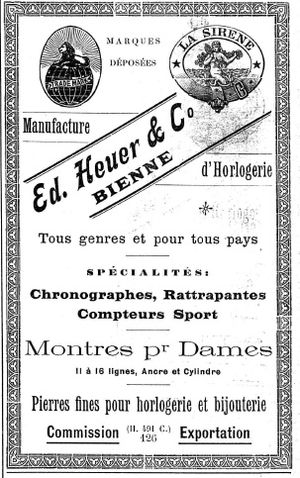Sammler-Uhren
Löbner Berlin Heuer Semikrograph Rattrapante Stopwatch WW1 ca. 1915
Löbner Berlin Heuer Semikrograph Rattrapante Stopwatch WW1 ca. 1915
Couldn't load pickup availability
Heuer Löbner / Berlin Semikrograph Rattrapanten Stopwatch Short-Timer from World War I, ca. 1915
What is a semimicrograph?
The term "semimicrograph" is a portmanteau of the Latin semi (half), the Greek mikro (small), and the Greek graph (writing). It refers to a stopwatch with a scale division of 0.02 (1/50) seconds.
To measure fiftieths of a second, the clock's balance must perform 50 semi-oscillations per second. This corresponds to a frequency of 25 hertz, which is 10 times faster than a normal pocket watch balance, which oscillates at 2.5 hertz. The balance's movements are therefore no longer perceptible to the human eye.
The oscillations of a micrograph are twice as fast, at 50 Hz = 100 semi-oscillations per second. Theoretically, this can measure 1/100 of a second. However, human reaction speed must be taken into account, which is in the tenths of a second range. This means that the high accuracy of these stopwatches cannot be utilized when operated manually. Therefore, most stopwatches operate with a tenth-of-a-second division.
The movement design of a semi-micrograph is similar to that of a column-wheel chronograph. To prevent the movement from running down prematurely, the balance is started with a small starting lever at 4 o'clock. In the movement shown here, this lever engages the circumference of the lever disc.
Semi-micrographs are often equipped with a split second hand that allows for timing of intermediate times. In the adjacent image, the second hand (blue) has already completed three rotations of the dial (3 x 6 seconds) and is at one second and 18/50. The split second hand (gold-colored) has stopped at 26/50.
Stopwatches of this type were kept in a metal case to protect them on the way to the sports field or into the field. Before use, the holder must be opened and the watch removed.
Description:
Interesting Heuer short-time stopwatch with ratrappante function, FL Löbner, so-called Semikrograph, ca. 1915
Case diameter: 58mm, approx. 127g, blued iron case, numbered 83542 inside, numbered and marked 2/F68 outside
Anchor movement of finest quality, presumably manufactured by Heuer, as the Semikrograph was patented by Heuer, very beautifully preserved enamel dial, marked FL Löbner Berlin W, Semikrograph, Swiss patent number 73392/93, functional
The black gunmetal casing also speaks for military use
These short-time stopwatches were primarily used for military short-time measurements and were also supplied to the German military, among others. The rare semi-micrograph completes a full rotation in just 6 seconds, allowing the measurement of tenths and fiftieths of a second (important for artillery!). The rattrapante function allows for the measurement of intermediate times.
This magnificent piece of watch history runs continuously (accuracy not tested, date of last service unknown)
EZ: 1 - 2 - good collector's condition! Few noticeable signs of age or wear, dial unrestored in excellent condition, runs and functions
History of the Heuer precision watch manufacturer (source: Watchwiki):
Heuer, Edouard

Swiss watchmaker
Edouard Heuer was born in 1840 as the son of a shoemaker in Brügg, Canton Bern.
In 1860, he founded the Heuer watchmaking company in Saint-Imier in the Swiss Jura. In 1864, he relocated the company to Biel . As early as 1876, he established a branch in London .
Edouard Heuer was the first watchmaker to venture into mass production of chronographs . His basic idea was to make chronographs technically simpler and thus cheaper to manufacture. His primary focus was on simplifying the previously standard clutch for the chronograph mechanism. This mechanism consisted of numerous components, the manufacturing, finishing, and assembly of which represented a significant cost factor.
The so-called oscillating pinion he developed is a no less effective module: a movably mounted shaft with two pinions. One pinion is in constant mesh with the second wheel of the movement , while the opposite pinion engages the chronograph's center wheel after the start pusher is pressed and a brief swing. This creates the connection, and the chronograph runs.
Pressing the button again moves the oscillating pinion away from the center wheel, stopping the chronograph . The Parisian Bureau de la Propriété Industrielle granted a patent for this development on May 3, 1887. This principle is still used today, for example, in the well-known automatic caliber Valjoux 7750 .
From 1880 onwards, Edouard Heuer was the first watchmaker to mass-produce chronographs .
Edouard Heuer died on April 30 , 1892 .
On 1 January 1964, the Heuer watch manufacturer and the Leonidas Watch Factory , Saint-Imier, merged to form Heuer-Leonidas .
In 1985, the company merged with the Techniques d'Avant Garde TAG Group and was renamed TAG Heuer




























